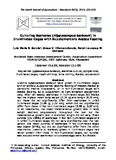Culturing seahorse (Hippocampus barbouri) in illuminated cages with supplementary Acetes feeding

Associated URL
evols.library.manoa.hawaii.eduDate
2010Page views
631Metadata
Show full item record
Share
Abstract
Juvenile Hippocampus barbouri were grown in illuminated cages with or without supplemental daytime feeding of thawed Acetes (a planktonic marine crustacean), or in non-illuminated cages with Acetes feeding, as a supplement to light-attracted zooplankton prey. After ten weeks, seahorses in illuminated cages fed Acetes had the highest mean body weight (2.24 g) and length (8.20 cm), but these did not significantly differ from seahorses in unfed illuminated cages (1.88 g; 7.25 cm), which did not significantly differ from those in fed non-illuminated cages (0.88 g; 6.32 cm). In all treatments, the mean instantaneous growth rate in body weight declined progressively throughout the test but the instantaneous growth rate in stretched length did not vary. Mean survival (76-100%) of seahorses in fed non-illuminated cages and in unfed illuminated cages did not vary significantly over the test period. The mean survival of seahorses in fed illuminated cages was lowest (54%), but did not significantly differ from the other treatments. Juvenile H. barbouri grown in illuminated cages had better growth than those in non-illuminated cages, but survival was reduced when seahorses in illuminated cages were fed Acetes.
Suggested Citation
Garcia, L. M., Hilomen-Garcia, G. V., & Calibara, R. L. M. (2010). Culturing seahorse (Hippocampus barbouri) in illuminated cages with supplementary Acetes feeding. The Israeli Journal of Aquaculture-Bamidgeh , 62(2), 122-129. http://hdl.handle.net/10862/1728
Taxonomic term
Collections
- AQD Journal Articles [1249]
